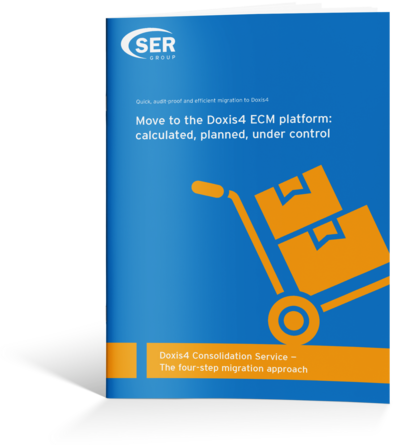SER Blog Innovation & Technology
No downtime, big impact: Content migration
Dominik Adams
An archive in accounting, a DMS in HR, plus file directories and workflow software spread throughout the company – this is not the model of modern information and business process management. With the right migration concept, however, you can consolidate uncontrolled growth and minimize the effort and risks involved in this change process.

According to an international survey conducted by AIIM, nearly 40% of organizations have five or more major content management systems. It’s not uncommon to find an even higher number – 10, 20 or even several hundred systems – at large corporations. You’ll typically find such content management infrastructures at companies with many subsidiaries or at companies in a post-acquisition/merger phase. For example, Deutsche Bahn, the Germany national railway, once faced the challenge of running about 20 different DMS solutions before migrating and consolidating to one central Bahn Content Management Platform.
This kind of organically grown and heterogeneous IT landscape is neither cost-efficient nor does it support business processes and collaboration. The operation of these systems alone requires a huge amount of maintenance and personnel, never mind the necessary training for administrators and users. What's more, expensive license and maintenance costs for the legacy systems take up a great deal of the IT budget. IT consolidation gives companies the golden opportunity to dramatically reduce the complexity of the application landscape while also cutting operating costs. The free capacities resulting from the consolidation can be actively used to improve information and business process management and to achieve competitive advantages.
Organically grown information silos
Outdated archives, DMS and workflow solutions no longer fulfill the requirements of modern information management. Their aging software architectures can’t handle the volume of managed documents, files or business processes and the number of users. The lack of interfaces exacerbates the integration with other applications. If current storage technologies are not supported, storage is expensive and slows down information retrieval. From the user's perspective, working with these kinds of systems gets frustrating over time – especially as work just gets slower and slower.
The result: chaotic filing structures, redundant data retention, and information silos. Not only is it hard for users to exchange data and information across the company, but it’s also difficult with external partners like suppliers and customers. If you add the information buried in email software and personal directories to the mixture, it quickly becomes clear that this is not a glowing example of efficient and conform data retention. A lot of potential is being lost here. Once you lose the overview on such a grand scale, you put your company at great risk of non-compliance.
For companies looking to utilize machine learning and content analytics, information stored across isolated repositories is an additional problem. The primary reason is that companies will only get top results from machine-learning technology if they have top quality data. Consolidating isolated repositories and migrating information to a centralized and modern ECM system has the advantage that it eliminates duplicate content and ROT and makes your documents and data ready for ML technologies.
It would be very foolhardy and costly to sit on your laurels in this situation. Even if you are happy with your application landscape despite these problems – you'll inevitably have to change something when support for your software solutions is no longer offered. The same is true for when the internal know-how for your system disappears over time. If you have system failure, no one can access your stored information – which can hardly be considered audit-proof archiving.
A method to the madness
How can you efficiently and intelligently make method of the IT madness that has emerged over time at your company? It's important to start with a stable ECM foundation. A cutting edge ECM solution, for instance, provides a sustainable and service-oriented software structure that grows with functional and technical requirements. Comprehensive integration options also help stop the accumulation of buried content. Furthermore, a modern ECM platform should be available in the cloud, on premises or as a hybrid solution – whatever fits your requirements. When ECM is joined with BPM on one uniform platform, both users and administrators benefit from this ideal pairing: information is brought together with business processes and made accessible to employees when and where ever it is needed.
One crucial step in an IT consolidation, especially for those who are looking to move to the cloud, is significantly reducing the number of information systems. Migrating key document sets and archives typically involves moving between 10,000 and hundreds of millions of documents and terabytes of data volumes. This also involves making sure the entire migration process is audit-proof – from data and document migration to tests and the documentation. Werner Hoetl of Duravit, a global leader in bathroom ceramics and products, spoke of the challenges of their own archive migration, "We realized ahead of time that several million documents couldn't be migrated just like that. Thanks to SER's integrated migration concept, we were able to gradually and successfully migrate about 20 million documents during live operation."
The size of projects such as the one at Duravit requires a solid integration and technology platform and a proven migration concept. While it's good to have a healthy amount of respect for a migration, it needn’t be daunting. What you need are proven and efficient procedures, migration know-how and the right software tool. These allow you to calculate, plan and control the migration process.

20 million documents securely migrated
Efficient global production processes and top-quality service are a must for Duravit, a world leader in bathroom ceramics and furniture. Find out here how consolidation and migration without downtime helped the company to reach its goals.
Read nowMigration without downtime
The Doxis Consolidation Service is an efficient alternative to classic migration, where all data of a legacy archive has to be exported first and then imported into the new system. The Doxis Consolidation Service, in contrast, allows you to migrate data step by step during live operation. First, only the document metadata is transferred. Most of the data to be migrated initially remains at the original storage location and is successively migrated in the background without reducing performance. A special storage adapter ensures access to the documents in the source system, independent of the archive system. The users don’t notice any difference – documents are equally accessible both via the source system and Doxis.
An independent migration environment ensures additional security and compliance conformity during the migration process. Moreover, all necessary metadata transformation is handled in the migration environment. In this step you have the opportunity to optimize the metadata, e.g. through conversion, restructuring and other measures. Throughout the migration process, the source system data is not modified. Another plus: The operating Doxis system is not overburdened.
Especially when dealing with a high volume of documents, this service streamlines the migration and considerably shortens project times, as Raiffeisen Bank International AG in Poland demonstrated: their migration was finished within four months. Essentially, companies save not only time, but also money. They can already decommission their old ECM systems directly after the metadata migration is complete. This saves significantly on operating and maintenance costs.

Migration to Doxis: calculated, planned, under control
Migrate large volumes of documents in a secure, quick way with SER's proven migration concept to effectively manage and harness the power of your information.
Read nowRoom to grow
IT consolidation is not an end in itself: companies need a sensible content migration and content federation strategy to fully tap the benefits of rationalized and modern information management. If done right, not only will your IT landscape thrive, but so will your company’s efficiency and employee experience.
Dominik Adams
Hi! I’m the Head of Product Marketing for the SER Group and a member of SER’s Innovation Team. Thus my daily business is talking and writing about some of my favorite topics: Technology trends and innovations, in particular those related to artificial intelligence, and finding ways to help our customers apply them in information management.

The latest digitization trends, laws and guidelines, and helpful tips straight to your inbox: Subscribe to our newsletter.
How can we help you?
+49 (0) 30 498582-0Your message has reached us!
We appreciate your interest and will get back to you shortly.




